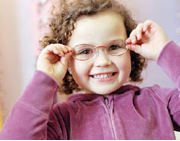Pediatric Eye Care
Support your child’s highest potential.
 Healthy vision is one of the most important components of your child’s wellness.
Healthy vision is one of the most important components of your child’s wellness.
Vision develops rapidly starting at birth and is tied to many developmental milestones, such as hand-eye coordination and reading. In the long term, your child’s vision will impact how they learn, play, and interact with the world.
While there may be some obvious signs of visual disorders, many vision problems can only be detected by a qualified eye doctor during a comprehensive eye exam.
Our caring staff makes the child’s visit a not-so-scary experience. We use special kid-friendly instruments to gather data on visual health, binocular function, and eye coordination…all of which are critical to learning. We only prescribe glasses when they are truly necessary, and we dispense high-quality frames and lenses with kid-tough guarantees. Our selection of children’s frames and sunglasses is one of the largest in the area.
We also fit children and teenagers with contact lenses and teach them to handle them safely. Ask about Corneal Refractive Therapy (CRT) for active teens and adults. Sleep in special contact lenses and be lens and glasses-free during the day!
Schedule an appointment at Palos Verdes Family Vision Optometry, and give your child the gift of clear vision.
Is your child having trouble seeing?
It is not always easy to spot vision problems in kids.
Some symptoms are more obvious, like squinting or holding reading materials very close. But often the early signs are subtle and can even be misdiagnosed.
Your child may be experiencing a vision problem if he or she does any of the following:
- Avoids reading and close-up work like coloring or doing puzzles
- Seems to work slowly or not understand the task
- Complains of fatigue or headaches
- Has a short attention span or seems distracted
- Covers one eye or tilts head when focusing on something
- Shows sensitivity to light
- Exhibits difficulty with coordination
Common eye disorders in children
Vision can be affected by many things, including the shape of the eyeball, how the eyes and brain work together, and by other diseases or medical conditions. The good news is that many eye disorders can be successfully identified and treated.
The most common eye disorders are caused by the shape and alignment of the eyes, including:
Strabismus is when the eyes do not align properly. This is often referred to as “crossed eyes.”
Amblyopia is poor vision in one eye, and is sometimes referred to as “lazy eye.” It usually occurs before the age of eight. Infants born prematurely or with low birth weight are at greater risk.
Refractive errors cause blurry images due to the shape of the eyeball or lens. These common conditions are easily treated with glasses or contact lenses. There are three types of refractive errors:
- Myopia or nearsightedness is good close vision but poor distance vision.
- Hyperopia or farsightedness is poor up-close vision. Distant objects can easily be seen.
- Astigmatism is imperfect vision at all distances.
Binocular alignment, tracking, and focusing difficulties can result in inefficient vision, avoidance of close work, and poor school performance. A complete exam will test for these skills, often more important than 20/20 eyesight!
Visual perceptual, visual motor, or directionality deficits can lead to letter reversals, spelling challenges and inattention at school. These skills can be evaluated and remediated as necessary.
Eye exam schedule for kids
Routine eye exams are a crucial part of your child’s well being and readiness for learning. Many parents do not know that school screenings or pediatrician visits are not the same as eye exams. Even with 20/20 vision, your child can still have problems that only an eye doctor can detect.
Newborns have their eyes checked before leaving the hospital. And leading medical organizations recommend comprehensive eye exams for health, vision development, and alignment at these ages:
- Between 6 and 12 months (ask us about the InfantSee program)
- 3 years of age
- Every year throughout the school years
Support your child’s highest potential — schedule an appointment at Palos Verdes Family Vision Optometry today.